✔零知IDE 是一个真正属于国人自己的开源软件平台,在开发效率上超越了Arduino平台并且更加容易上手,大大降低了开发难度。零知开源在软件方面提供了完整的学习教程和丰富示例代码,让不懂程序的工程师也能非常轻而易举的搭建电路来创作产品,测试产品。快来动手试试吧!
✔访问零知实验室,获取更多实战项目和教程资源吧!
目录
(1)项目概述
本项目基于零知增强板(主控芯片STM32F407VET6)和ADXL345三轴加速度计,开发了一套完整的实时姿态监测系统。通过先进的滤波算法和自动校准技术,实现了高精度的姿态角度解算,并通过Processing平台实现了三维可视化界面。该系统能够实时显示设备的滚转、俯仰角度,并记录历史数据变化趋势。
(2)项目亮点
>结合卡尔曼滤波和移动平均滤波,有效降低传感器噪声
>智能六点校准算法,无需手动干预
>Processing三维实时显示,支持历史数据回溯
(3)项目难点及解决方案
问题描述:传感器存在明显噪声和动态漂移
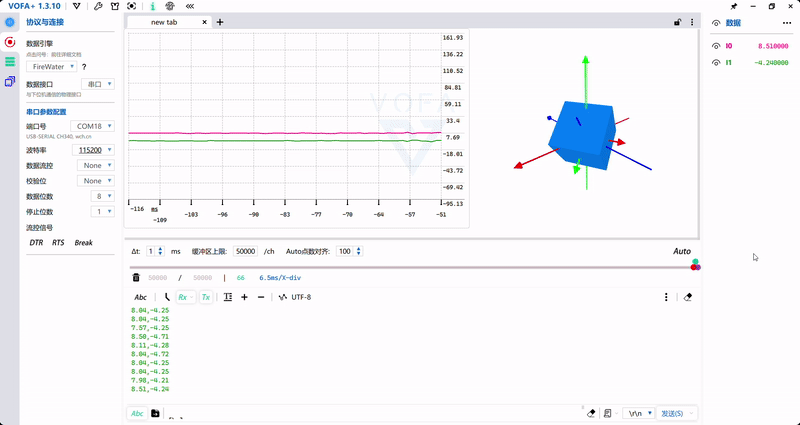
解决方案:采用双重滤波算法(卡尔曼滤波+移动平均滤波),设置合理的滤波参数,有效抑制噪声同时保持响应速度。
一、硬件设计部分
1.1 硬件清单
| 组件名称 | 规格型号 | 数量 | 备注 |
|---|---|---|---|
| 零知增强板 | STM32F407VET6主控 | 1 | 核心控制器 |
| ADXL345模块 | 三轴加速度计 | 1 | 姿态传感器 |
| 杜邦线 | 20cm | 4 | 连接线材 |
| 微型USB线 | / | 1 | 供电与编程 |
1.2 接线方案
| ADXL345引脚 | 零知增强板引脚 | 功能说明 |
|---|---|---|
| VCC | 5V | 电源正极 |
| GND | GND | 电源地 |
| SDA | 20/SDA | I2C数据线 |
| SCL | 21/SCL | I2C时钟线 |
1.3 连接硬件图
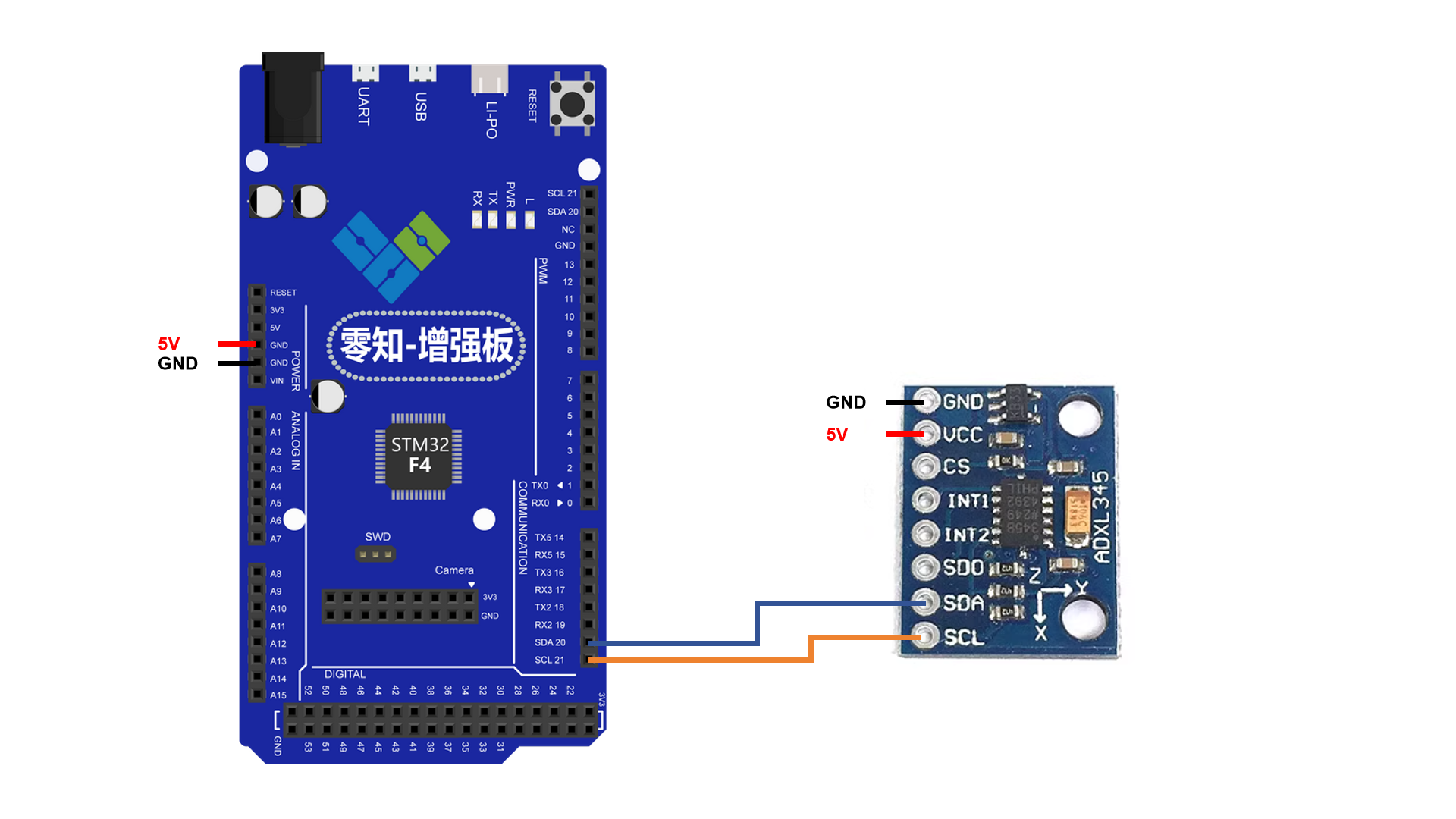
ADXL345模块通过I2C接口与零知增强板连接,使用5V供电
1.4 接线实物图

二、软件架构部分
2.1 初始化结构
#include <Wire.h>
// ADXL345 I2C地址
#define ADXL345_ADDRESS 0x53
// ADXL345寄存器地址
#define ADXL345_REG_DEVID 0x00
#define ADXL345_REG_POWER_CTL 0x2D
#define ADXL345_REG_DATA_FORMAT 0x31
#define ADXL345_REG_DATAX0 0x32
#define ADXL345_REG_BW_RATE 0x2C
#define ADXL345_REG_OFSX 0x1E
#define ADXL345_REG_OFSY 0x1F
#define ADXL345_REG_OFSZ 0x20
// 高级滤波参数
#define MOVING_AVG_SIZE 7 // 移动平均窗口大小
#define KALMAN_Q 0.01 // 卡尔曼滤波过程噪声
#define KALMAN_R 0.1 // 卡尔曼滤波测量噪声
#define STABILITY_THRESHOLD 0.02 // 稳定性阈值(g)
// 校准参数
float xOffset = 0, yOffset = 0, zOffset = 0;
bool calibrated = false;
// 滤波结构体
typedef struct {
float q; // 过程噪声协方差
float r; // 测量噪声协方差
float x; // 估计值
float p; // 估计误差协方差
float k; // 卡尔曼增益
} KalmanFilter;
KalmanFilter kalmanX, kalmanY, kalmanZ;
// ADXL345初始化函数
void initADXL345() {
Wire.begin();
// 检查设备ID
byte deviceID = readRegister(ADXL345_REG_DEVID);
if (deviceID != 0xE5) {
Serial.println("Error: ADXL345 not found");
while(1);
}
// 设置数据速率和带宽为100Hz
writeRegister(ADXL345_REG_BW_RATE, 0x0B);
// 设置数据格式为±4g,全分辨率模式
writeRegister(ADXL345_REG_DATA_FORMAT, 0x09);
// 启用测量模式
writeRegister(ADXL345_REG_POWER_CTL, 0x08);
Serial.println("ADXL345 initialized successfully");
}MOVING_AVG_SIZE = 7:移动平均窗口大小,影响平滑度和响应速度
STABILITY_THRESHOLD = 0.02:稳定性判断阈值,小于此值认为设备稳定
2.2 卡尔曼滤波
// 移动平均滤波
float movingAvgBufferX[MOVING_AVG_SIZE];
float movingAvgBufferY[MOVING_AVG_SIZE];
float movingAvgBufferZ[MOVING_AVG_SIZE];
int movingAvgIndex = 0;
// 稳定性检测
unsigned long lastStableTime = 0;
bool isStable = false;
// 初始化卡尔曼滤波器
void initKalmanFilter(KalmanFilter *kf, float q, float r, float initialValue) {
kf->q = q;
kf->r = r;
kf->x = initialValue;
kf->p = 1.0;
kf->k = 0;
}
// 卡尔曼滤波更新
float updateKalmanFilter(KalmanFilter *kf, float measurement) {
// 预测
kf->p = kf->p + kf->q;
// 更新
kf->k = kf->p / (kf->p + kf->r);
kf->x = kf->x + kf->k * (measurement - kf->x);
kf->p = (1 - kf->k) * kf->p;
return kf->x;
}
// 应用卡尔曼滤波
void applyKalmanFilter(float &x, float &y, float &z) {
x = updateKalmanFilter(&kalmanX, x);
y = updateKalmanFilter(&kalmanY, y);
z = updateKalmanFilter(&kalmanZ, z);
}
2.3 平均滤波及校准算法
// 应用移动平均滤波
void applyMovingAverageFilter(float &x, float &y, float &z) {
// 更新缓冲区
movingAvgBufferX[movingAvgIndex] = x;
movingAvgBufferY[movingAvgIndex] = y;
movingAvgBufferZ[movingAvgIndex] = z;
movingAvgIndex = (movingAvgIndex + 1) % MOVING_AVG_SIZE;
// 计算平均值
float xSum = 0, ySum = 0, zSum = 0;
for (int i = 0; i < MOVING_AVG_SIZE; i++) {
xSum += movingAvgBufferX[i];
ySum += movingAvgBufferY[i];
zSum += movingAvgBufferZ[i];
}
x = xSum / MOVING_AVG_SIZE;
y = ySum / MOVING_AVG_SIZE;
z = zSum / MOVING_AVG_SIZE;
}
// 自动校准函数
void autoCalibrate() {
Serial.println("Start automatic calibration...");
Serial.println("Please ensure that the sensor is placed horizontally and stationary");
// 等待2秒让用户放置传感器
delay(2000);
float xSum = 0, ySum = 0, zSum = 0;
const int samples = 200;
int validSamples = 0;
// 采集多个样本求平均值
for (int i = 0; i < samples; i++) {
float x, y, z;
readAcceleration(x, y, z);
// 检查数据有效性
if (!isnan(x) && !isnan(y) && !isnan(z)) {
xSum += x;
ySum += y;
zSum += z;
validSamples++;
}
delay(10); // 每10ms采集一次
}
if (validSamples > 0) {
// 计算偏移量
xOffset = xSum / validSamples;
yOffset = ySum / validSamples;
zOffset = zSum / validSamples - 1.0; // 减去重力加速度
// 设置硬件偏移寄存器
writeRegister(ADXL345_REG_OFSX, (byte)(xOffset / 0.0156));
writeRegister(ADXL345_REG_OFSY, (byte)(yOffset / 0.0156));
writeRegister(ADXL345_REG_OFSZ, (byte)(zOffset / 0.0156));
calibrated = true;
Serial.println("Automatic calibration completed!");
Serial.print("XOffset: "); Serial.print(xOffset, 6);
Serial.print(" g, YOffset: "); Serial.print(yOffset, 6);
Serial.print(" g, ZOffset: "); Serial.print(zOffset, 6);
Serial.println(" g");
} else {
Serial.println("Calibration failure: No valid data can be obtained");
}
}
// 处理串口命令
void processSerialCommands() {
if (Serial.available()) {
char command = Serial.read();
if (command == 'c' || command == 'C') {
autoCalibrate();
} else if (command == 'r' || command == 'R') {
// 重置校准数据
calibrated = false;
xOffset = 0;
yOffset = 0;
zOffset = 0;
writeRegister(ADXL345_REG_OFSX, 0);
writeRegister(ADXL345_REG_OFSY, 0);
writeRegister(ADXL345_REG_OFSZ, 0);
Serial.println("The calibration data has been reset");
} else if (command == 's' || command == 'S') {
// 显示状态
Serial.print("校准状态 : ");
Serial.println(calibrated ? "Calibrated Resistance" : "Uncalibrated");
Serial.print("XOffset: "); Serial.println(xOffset, 6);
Serial.print("YOffset: "); Serial.println(yOffset, 6);
Serial.print("ZOffset: "); Serial.println(zOffset, 6);
}
}
}
2.4 Processing可视化代码
import processing.serial.*;
// 传感器数据
float roll, pitch, yaw;
PVector accelerometer = new PVector();
PVector gyroscope = new PVector(0, 0, 0);
PVector magneticField = new PVector(0, 0, 0);
// 3D模型
PShape model;
PImage bgImage;
// 串口配置
Serial port;
String[] serialPorts;
int selectedPort = 0;
boolean printSerial = true;
boolean connected = false;
// 历史数据
float[] rollHistory = new float[200];
float[] pitchHistory = new float[200];
int historyIndex = 0;
// UI颜色主题
color backgroundColor = color(30, 30, 40);
color panelColor = color(40, 40, 50, 200);
color textColor = color(220, 220, 220);
color accentColor = color(65, 105, 225); // 皇家蓝
color rollColor = color(220, 80, 80); // 红色
color pitchColor = color(80, 220, 80); // 绿色
color yawColor = color(80, 80, 220); // 蓝色
// 字体
PFont dataFont, titleFont;
void setup() {
size(1400, 900, P3D);
frameRate(60);
// 创建字体
dataFont = createFont("Arial", 16);
titleFont = createFont("Arial Bold", 20);
// 创建默认背景
bgImage = createGradientBackground();
// 创建默认模型 - 更大的立方体
model = createEnhancedCube();
// 初始化串口
serialPorts = Serial.list();
if (serialPorts.length > 0) {
connectSerial(serialPorts[0]);
}
// 初始化历史数据
for (int i = 0; i < rollHistory.length; i++) {
rollHistory[i] = 0;
pitchHistory[i] = 0;
}
println("等待数据...");
}
PImage createGradientBackground() {
PGraphics pg = createGraphics(width, height);
pg.beginDraw();
pg.background(backgroundColor);
// 添加渐变效果
for (int i = 0; i < height; i++) {
float inter = map(i, 0, height, 0, 1);
color c = lerpColor(color(20, 20, 30), color(40, 40, 60), inter);
pg.stroke(c);
pg.line(0, i, width, i);
}
// 添加网格线
pg.stroke(50, 100);
for (int x = 0; x < width; x += 50) {
pg.line(x, 0, x, height);
}
for (int y = 0; y < height; y += 50) {
pg.line(0, y, width, y);
}
pg.endDraw();
return pg.get();
}
PShape createEnhancedCube() {
// 创建一个更详细、更大的立方体模型
PShape cube = createShape(GROUP);
// 立方体主体 (100x100x100)
PShape mainBody = createShape(BOX, 150, 150, 150);
mainBody.setFill(color(180, 100, 100, 200));
mainBody.setStroke(false);
cube.addChild(mainBody);
// 添加边缘高光
PShape edges = createShape();
edges.beginShape(LINES);
edges.stroke(255, 150);
edges.strokeWeight(2);
// 立方体边缘
float s = 75; // 半边长
edges.vertex(-s, -s, -s); edges.vertex(s, -s, -s);
edges.vertex(-s, -s, -s); edges.vertex(-s, s, -s);
edges.vertex(-s, -s, -s); edges.vertex(-s, -s, s);
edges.vertex(s, s, s); edges.vertex(-s, s, s);
edges.vertex(s, s, s); edges.vertex(s, -s, s);
edges.vertex(s, s, s); edges.vertex(s, s, -s);
edges.vertex(-s, s, -s); edges.vertex(s, s, -s);
edges.vertex(-s, s, -s); edges.vertex(-s, s, s);
edges.vertex(s, -s, -s); edges.vertex(s, s, -s);
edges.vertex(s, -s, -s); edges.vertex(s, -s, s);
edges.vertex(-s, -s, s); edges.vertex(s, -s, s);
edges.vertex(-s, -s, s); edges.vertex(-s, s, s);
edges.endShape();
cube.addChild(edges);
// 添加方向指示器
PShape xIndicator = createShape(SPHERE, 10);
xIndicator.setFill(rollColor);
xIndicator.setStroke(false);
xIndicator.translate(85, 0, 0);
cube.addChild(xIndicator);
PShape yIndicator = createShape(SPHERE, 10);
yIndicator.setFill(pitchColor);
yIndicator.setStroke(false);
yIndicator.translate(0, 85, 0);
cube.addChild(yIndicator);
PShape zIndicator = createShape(SPHERE, 10);
zIndicator.setFill(yawColor);
zIndicator.setStroke(false);
zIndicator.translate(0, 0, 85);
cube.addChild(zIndicator);
return cube;
}
void draw() {
// 绘制背景
image(bgImage, 0, 0);
// 绘制3D场景 (占据左侧大部分区域)
draw3DScene();
// 绘制数据面板 (右侧)
drawDataPanel();
// 绘制波形图 (右下角)
drawWaveformGraph();
// 绘制连接状态
drawConnectionStatus();
}
void draw3DScene() {
pushMatrix();
// 将3D场景移到左侧中心,占据更大空间
translate(width/3, height/2, 0);
// 设置灯光 - 增强照明
lights();
directionalLight(150, 150, 150, 0, 0, -1);
directionalLight(100, 100, 100, 0, 1, 0);
directionalLight(80, 80, 80, 1, 0, 0);
lightSpecular(255, 255, 255);
shininess(20.0);
// 应用旋转 - 调整Z轴方向
// 注意: Processing默认Y向上,我们需要调整使Z向上
rotateX(radians(0)); // 先旋转使Z轴向上
rotateZ(radians(-roll));
rotateX(radians(-pitch));
rotateY(radians(-yaw)); // 调整yaw旋转方向
// 绘制参考坐标系 (更大)
drawCoordinateSystem();
// 绘制模型
shape(model);
popMatrix();
}
void drawCoordinateSystem() {
float axisLength = 120;
// 绘制X轴 (红色)
strokeWeight(3);
stroke(rollColor);
line(0, 0, 0, axisLength, 0, 0);
pushMatrix();
translate(axisLength + 15, 0, 0);
fill(rollColor);
textFont(titleFont);
text("Y", 0, 0);
popMatrix();
// 绘制Y轴 (绿色)
stroke(pitchColor);
line(0, 0, 0, 0, axisLength, 0);
pushMatrix();
translate(0, axisLength + 15, 0);
fill(pitchColor);
text("Z", 0, 0);
popMatrix();
// 绘制Z轴 (蓝色) - 现在向上
stroke(yawColor);
line(0, 0, 0, 0, 0, axisLength);
pushMatrix();
translate(0, 0, axisLength + 15);
fill(yawColor);
text("X", 0, 0);
popMatrix();
strokeWeight(1);
}
void drawDataPanel() {
// 绘制数据面板背景 (右侧)
float panelWidth = 400;
float panelX = width - panelWidth - 20;
fill(panelColor);
noStroke();
rect(panelX, 20, panelWidth, 280, 10);
// 面板标题
fill(accentColor);
textFont(titleFont);
textAlign(LEFT, TOP);
text("Sensor Data Panel", panelX + 15, 30);
// 显示传感器数据
textFont(dataFont);
fill(textColor);
String accelX = Float.isNaN(accelerometer.x) ? "N/A" : nfp(accelerometer.x, 1, 3);
String accelY = Float.isNaN(accelerometer.y) ? "N/A" : nfp(accelerometer.y, 1, 3);
String accelZ = Float.isNaN(accelerometer.z) ? "N/A" : nfp(accelerometer.z, 1, 3);
String yawStr = Float.isNaN(yaw) ? "N/A" : nfp(yaw, 1, 1);
String pitchStr = Float.isNaN(pitch) ? "N/A" : nfp(pitch, 1, 1);
String rollStr = Float.isNaN(roll) ? "N/A" : nfp(roll, 1, 1);
// 使用表格形式显示数据
float startY = 70;
float rowHeight = 30;
// 表头
fill(accentColor);
text("parameter:", panelX + 20, startY);
text("value:", panelX + 200, startY);
// 加速度数据
drawDataRow("accelerate X:", accelX + " g", startY + rowHeight, rollColor);
drawDataRow("accelerate Y:", accelY + " g", startY + rowHeight * 2, pitchColor);
drawDataRow("accelerate Z:", accelZ + " g", startY + rowHeight * 3, yawColor);
// 姿态数据
drawDataRow("Roll:", rollStr + "°", startY + rowHeight * 5, rollColor);
drawDataRow("Pitch:", pitchStr + "°", startY + rowHeight * 6, pitchColor);
drawDataRow("Yaw:", yawStr + "°", startY + rowHeight * 7, yawColor);
}
void drawDataRow(String label, String value, float y, color c) {
float panelX = width - 400 - 20;
fill(textColor);
text(label, panelX + 20, y);
fill(c);
text(value, panelX + 200, y);
}
void drawWaveformGraph() {
float graphX = width - 420;
float graphY = 320;
float graphWidth = 400;
float graphHeight = 250;
// 绘制波形图背景
fill(panelColor);
noStroke();
rect(graphX, graphY, graphWidth, graphHeight, 10);
// 标题
fill(accentColor);
textFont(titleFont);
text("Angle Waveform Diagram", graphX + 15, graphY + 15);
// 绘制网格
drawWaveformGrid(graphX, graphY, graphWidth, graphHeight);
// 绘制零线
stroke(150, 150);
float zeroY = graphY + graphHeight / 2;
line(graphX, zeroY, graphX + graphWidth, zeroY);
// 绘制Roll历史
stroke(rollColor);
drawWaveformLine(graphX, graphY, graphWidth, graphHeight, rollHistory, -90, 90);
// 绘制Pitch历史
stroke(pitchColor);
drawWaveformLine(graphX, graphY, graphWidth, graphHeight, pitchHistory, -90, 90);
// 绘制标签
fill(textColor);
textFont(dataFont);
textAlign(LEFT);
text("Roll", graphX, graphY + graphHeight + 40);
fill(rollColor);
rect(graphX + 40, graphY + graphHeight + 30, 15, 5);
fill(textColor);
text("Pitch", graphX, graphY + graphHeight + 70);
fill(pitchColor);
rect(graphX + 40, graphY + graphHeight + 62, 15, 5);
// 绘制刻度
fill(150);
textAlign(CENTER);
text("-90°", graphX, graphY + graphHeight + 20);
text("0°", graphX + graphWidth / 2, graphY + graphHeight + 20);
text("90°", graphX + graphWidth, graphY + graphHeight + 20);
}
void drawWaveformGrid(float x, float y, float w, float h) {
stroke(80, 100);
// 水平网格线
for (int i = 1; i < 4; i++) {
float lineY = y + h * i / 4;
line(x, lineY, x + w, lineY);
}
// 垂直网格线
for (int i = 1; i < 5; i++) {
float lineX = x + w * i / 5;
line(lineX, y, lineX, y + h);
}
}
void drawWaveformLine(float x, float y, float w, float h, float[] history, float minVal, float maxVal) {
noFill();
beginShape();
for (int i = 0; i < history.length; i++) {
float xPos = x + map(i, 0, history.length - 1, 0, w);
float yPos = y + h/2 - map(history[i], minVal, maxVal, -h/2, h/2);
vertex(xPos, yPos);
}
endShape();
}
void drawConnectionStatus() {
float statusX = 20;
float statusY = height - 80;
// 连接状态背景
fill(panelColor);
noStroke();
rect(statusX, statusY, 300, 60, 8);
// 连接状态指示器
fill(connected ? color(0, 200, 0) : color(200, 0, 0));
ellipse(statusX + 20, statusY + 20, 15, 15);
fill(textColor);
textFont(dataFont);
textAlign(LEFT, CENTER);
text("UART: " + (connected ? serialPorts[selectedPort] : "No connection"), statusX + 45, statusY + 20);
text("Data receiving: " + (millis() - lastDataTime < 1000 ? "Normal" : "No found"), statusX + 45, statusY + 40);
// 指令提示
text("Press the space bar to switch the serial port | C:Calibration | R:Reset", statusX, statusY + 70);
}
void checkDataReceiving() {
// 检查数据接收状态
if (millis() - lastDataTime > 1000) {
dataReceived = 0;
}
}
void serialEvent(Serial p) {
try {
String rawData = p.readStringUntil('\n');
if (rawData == null) return;
rawData = rawData.trim();
if (printSerial) println("Raw: " + rawData);
String[] parts = split(rawData, ' ');
if (parts.length >= 4) {
if (parts[0].equals("Or:")) {
// 解析姿态数据: Or: yaw pitch roll
try {
yaw = float(parts[1]);
pitch = float(parts[2]);
roll = float(parts[3]);
// 检查NaN值
if (Float.isNaN(yaw)) yaw = 0;
if (Float.isNaN(pitch)) pitch = 0;
if (Float.isNaN(roll)) roll = 0;
// 更新历史数据
rollHistory[historyIndex] = roll;
pitchHistory[historyIndex] = pitch;
historyIndex = (historyIndex + 1) % rollHistory.length;
dataReceived |= 1;
lastDataTime = millis();
} catch (Exception e) {
println("Error parsing orientation data: " + e.getMessage());
}
} else if (parts[0].equals("Accel:")) {
// 解析加速度数据: Accel: x y z
try {
float accelX = float(parts[1]);
float accelY = float(parts[2]);
float accelZ = float(parts[3]);
// 检查NaN值
if (Float.isNaN(accelX)) accelX = 0;
if (Float.isNaN(accelY)) accelY = 0;
if (Float.isNaN(accelZ)) accelZ = 0;
accelerometer.set(accelX, accelY, accelZ);
dataReceived |= 2;
lastDataTime = millis();
} catch (Exception e) {
println("Error parsing acceleration data: " + e.getMessage());
}
}
}
} catch(Exception e) {
println("Serial Error: " + e.getMessage());
}
}
// 全局变量用于跟踪数据接收状态
int dataReceived = 0;
long lastDataTime = 0;
void connectSerial(String portName) {
if (port != null) {
port.stop();
}
try {
port = new Serial(this, portName, 115200);
port.bufferUntil('\n');
connected = true;
println("Connected to: " + portName);
} catch(Exception e) {
println("Connection failed: " + e.getMessage());
connected = false;
}
}
void keyPressed() {
// 切换串口
if (key == ' ') {
if (serialPorts.length > 0) {
selectedPort = (selectedPort + 1) % serialPorts.length;
connectSerial(serialPorts[selectedPort]);
}
}
// 切换调试输出
if (key == 'P' || key == 'p') {
printSerial = !printSerial;
println("Serial print: " + (printSerial ? "ON" : "OFF"));
}
// 重置视角
if (key == 'R' || key == 'r') {
yaw = pitch = roll = 0;
println("View reset");
}
// 发送校准命令
if (key == 'C' || key == 'c') {
if (port != null) {
port.write('c');
println("Sent calibration command");
}
}
}UI设计界面:左侧3D实时渲染区域,右侧数据展示、实时波形图显示历史数据趋势
2.5 加速度计完整代码
#include <Wire.h>
// ADXL345 I2C地址
#define ADXL345_ADDRESS 0x53
// ADXL345寄存器地址
#define ADXL345_REG_DEVID 0x00
#define ADXL345_REG_POWER_CTL 0x2D
#define ADXL345_REG_DATA_FORMAT 0x31
#define ADXL345_REG_DATAX0 0x32
#define ADXL345_REG_BW_RATE 0x2C
#define ADXL345_REG_OFSX 0x1E
#define ADXL345_REG_OFSY 0x1F
#define ADXL345_REG_OFSZ 0x20
// 高级滤波参数
#define MOVING_AVG_SIZE 7 // 移动平均窗口大小
#define KALMAN_Q 0.01 // 卡尔曼滤波过程噪声
#define KALMAN_R 0.1 // 卡尔曼滤波测量噪声
#define STABILITY_THRESHOLD 0.02 // 稳定性阈值(g)
// 校准参数
float xOffset = 0, yOffset = 0, zOffset = 0;
bool calibrated = false;
// 滤波结构体
typedef struct {
float q; // 过程噪声协方差
float r; // 测量噪声协方差
float x; // 估计值
float p; // 估计误差协方差
float k; // 卡尔曼增益
} KalmanFilter;
KalmanFilter kalmanX, kalmanY, kalmanZ;
// 移动平均滤波
float movingAvgBufferX[MOVING_AVG_SIZE];
float movingAvgBufferY[MOVING_AVG_SIZE];
float movingAvgBufferZ[MOVING_AVG_SIZE];
int movingAvgIndex = 0;
// 稳定性检测
unsigned long lastStableTime = 0;
bool isStable = false;
// 初始化卡尔曼滤波器
void initKalmanFilter(KalmanFilter *kf, float q, float r, float initialValue) {
kf->q = q;
kf->r = r;
kf->x = initialValue;
kf->p = 1.0;
kf->k = 0;
}
// 卡尔曼滤波更新
float updateKalmanFilter(KalmanFilter *kf, float measurement) {
// 预测
kf->p = kf->p + kf->q;
// 更新
kf->k = kf->p / (kf->p + kf->r);
kf->x = kf->x + kf->k * (measurement - kf->x);
kf->p = (1 - kf->k) * kf->p;
return kf->x;
}
// ADXL345初始化函数
void initADXL345() {
Wire.begin();
// 检查设备ID
byte deviceID = readRegister(ADXL345_REG_DEVID);
if (deviceID != 0xE5) {
Serial.println("Error: ADXL345 not found");
while(1);
}
// 设置数据速率和带宽为100Hz
writeRegister(ADXL345_REG_BW_RATE, 0x0B);
// 设置数据格式为±4g,全分辨率模式
writeRegister(ADXL345_REG_DATA_FORMAT, 0x09);
// 启用测量模式
writeRegister(ADXL345_REG_POWER_CTL, 0x08);
Serial.println("ADXL345 initialized successfully");
}
// 写入寄存器函数
void writeRegister(byte reg, byte value) {
Wire.beginTransmission(ADXL345_ADDRESS);
Wire.write(reg);
Wire.write(value);
Wire.endTransmission();
}
// 读取寄存器函数
byte readRegister(byte reg) {
Wire.beginTransmission(ADXL345_ADDRESS);
Wire.write(reg);
Wire.endTransmission();
Wire.requestFrom(ADXL345_ADDRESS, 1);
return Wire.read();
}
// 读取加速度数据
void readAcceleration(float &x, float &y, float &z) {
Wire.beginTransmission(ADXL345_ADDRESS);
Wire.write(ADXL345_REG_DATAX0);
Wire.endTransmission();
// 检查是否有数据可用
if (Wire.requestFrom(ADXL345_ADDRESS, 6) == 6) {
// 读取原始数据
int16_t xRaw = (Wire.read() | (Wire.read() << 8));
int16_t yRaw = (Wire.read() | (Wire.read() << 8));
int16_t zRaw = (Wire.read() | (Wire.read() << 8));
// 转换为g值 (±4g范围,全分辨率模式)
x = xRaw * 0.0078;
y = yRaw * 0.0078;
z = zRaw * 0.0078;
// 应用校准偏移
if (calibrated) {
x -= xOffset;
y -= yOffset;
z -= zOffset;
}
} else {
// 读取失败,设置为0
x = y = z = 0;
Serial.println("Error: Failed to read acceleration data");
}
}
// 应用移动平均滤波
void applyMovingAverageFilter(float &x, float &y, float &z) {
// 更新缓冲区
movingAvgBufferX[movingAvgIndex] = x;
movingAvgBufferY[movingAvgIndex] = y;
movingAvgBufferZ[movingAvgIndex] = z;
movingAvgIndex = (movingAvgIndex + 1) % MOVING_AVG_SIZE;
// 计算平均值
float xSum = 0, ySum = 0, zSum = 0;
for (int i = 0; i < MOVING_AVG_SIZE; i++) {
xSum += movingAvgBufferX[i];
ySum += movingAvgBufferY[i];
zSum += movingAvgBufferZ[i];
}
x = xSum / MOVING_AVG_SIZE;
y = ySum / MOVING_AVG_SIZE;
z = zSum / MOVING_AVG_SIZE;
}
// 应用卡尔曼滤波
void applyKalmanFilter(float &x, float &y, float &z) {
x = updateKalmanFilter(&kalmanX, x);
y = updateKalmanFilter(&kalmanY, y);
z = updateKalmanFilter(&kalmanZ, z);
}
// 检测稳定性
bool checkStability(float x, float y, float z, float prevX, float prevY, float prevZ) {
float deltaX = abs(x - prevX);
float deltaY = abs(y - prevY);
float deltaZ = abs(z - prevZ);
return (deltaX < STABILITY_THRESHOLD &&
deltaY < STABILITY_THRESHOLD &&
deltaZ < STABILITY_THRESHOLD);
}
// 计算Roll和Pitch角度
void calculateAngles(float x, float y, float z, float &roll, float &pitch) {
// 检查数据有效性,避免除零错误和NaN
if (isnan(x) || isnan(y) || isnan(z)) {
roll = pitch = 0;
return;
}
// 使用改进的公式计算Roll和Pitch
float denominator = sqrt(x*x + z*z);
if (denominator < 0.001) denominator = 0.001; // 避免除零错误
roll = atan2(y, denominator) * 180.0 / PI;
denominator = sqrt(y*y + z*z);
if (denominator < 0.001) denominator = 0.001; // 避免除零错误
pitch = atan2(-x, denominator) * 180.0 / PI;
}
// 自动校准函数
void autoCalibrate() {
Serial.println("Start automatic calibration...");
Serial.println("Please ensure that the sensor is placed horizontally and stationary");
// 等待2秒让用户放置传感器
delay(2000);
float xSum = 0, ySum = 0, zSum = 0;
const int samples = 200;
int validSamples = 0;
// 采集多个样本求平均值
for (int i = 0; i < samples; i++) {
float x, y, z;
readAcceleration(x, y, z);
// 检查数据有效性
if (!isnan(x) && !isnan(y) && !isnan(z)) {
xSum += x;
ySum += y;
zSum += z;
validSamples++;
}
delay(10); // 每10ms采集一次
}
if (validSamples > 0) {
// 计算偏移量
xOffset = xSum / validSamples;
yOffset = ySum / validSamples;
zOffset = zSum / validSamples - 1.0; // 减去重力加速度
// 设置硬件偏移寄存器
writeRegister(ADXL345_REG_OFSX, (byte)(xOffset / 0.0156));
writeRegister(ADXL345_REG_OFSY, (byte)(yOffset / 0.0156));
writeRegister(ADXL345_REG_OFSZ, (byte)(zOffset / 0.0156));
calibrated = true;
Serial.println("Automatic calibration completed!");
Serial.print("XOffset: "); Serial.print(xOffset, 6);
Serial.print(" g, YOffset: "); Serial.print(yOffset, 6);
Serial.print(" g, ZOffset: "); Serial.print(zOffset, 6);
Serial.println(" g");
} else {
Serial.println("Calibration failure: No valid data can be obtained");
}
}
// 处理串口命令
void processSerialCommands() {
if (Serial.available()) {
char command = Serial.read();
if (command == 'c' || command == 'C') {
autoCalibrate();
} else if (command == 'r' || command == 'R') {
// 重置校准数据
calibrated = false;
xOffset = 0;
yOffset = 0;
zOffset = 0;
writeRegister(ADXL345_REG_OFSX, 0);
writeRegister(ADXL345_REG_OFSY, 0);
writeRegister(ADXL345_REG_OFSZ, 0);
Serial.println("The calibration data has been reset");
} else if (command == 's' || command == 'S') {
// 显示状态
Serial.print("校准状态 : ");
Serial.println(calibrated ? "Calibrated Resistance" : "Uncalibrated");
Serial.print("XOffset: "); Serial.println(xOffset, 6);
Serial.print("YOffset: "); Serial.println(yOffset, 6);
Serial.print("ZOffset: "); Serial.println(zOffset, 6);
}
}
}
void setup() {
Serial.begin(115200);
// 初始化I2C
Wire.begin();
// 初始化滤波缓冲区
for (int i = 0; i < MOVING_AVG_SIZE; i++) {
movingAvgBufferX[i] = 0;
movingAvgBufferY[i] = 0;
movingAvgBufferZ[i] = 0;
}
// 初始化卡尔曼滤波器
initKalmanFilter(&kalmanX, KALMAN_Q, KALMAN_R, 0);
initKalmanFilter(&kalmanY, KALMAN_Q, KALMAN_R, 0);
initKalmanFilter(&kalmanZ, KALMAN_Q, KALMAN_R, 1.0); // Z轴初始值为1g
initADXL345();
Serial.println("The ADXL345 attitude sensor is ready");
Serial.println("Available commands:");
Serial.println("c - START CALIBRATION");
Serial.println("r - RESET the Calibration Data");
Serial.println("s - DISPLAY STATUS");
Serial.println("DATA FORMAT: Or: yaw pitch roll");
Serial.println(" Accel: x y z");
}
void loop() {
// 处理串口命令
processSerialCommands();
static float prevX = 0, prevY = 0, prevZ = 0;
float x, y, z;
// 读取加速度数据
readAcceleration(x, y, z);
// 检查数据有效性
if (isnan(x) || isnan(y) || isnan(z)) {
Serial.println("Warning: Invalid acceleration data");
delay(100);
return;
}
// 应用移动平均滤波
applyMovingAverageFilter(x, y, z);
// 应用卡尔曼滤波
applyKalmanFilter(x, y, z);
// 检测稳定性
isStable = checkStability(x, y, z, prevX, prevY, prevZ);
if (isStable) {
lastStableTime = millis();
}
// 计算Roll和Pitch角度
float roll, pitch;
calculateAngles(x, y, z, roll, pitch);
// 检查角度数据有效性
if (isnan(roll) || isnan(pitch)) {
Serial.println("Warning: Invalid angle data");
roll = pitch = 0;
}
// 输出数据到Processing
Serial.print("Or: ");
Serial.print(0); // Yaw始终为0
Serial.print(" ");
Serial.print(pitch);
Serial.print(" ");
Serial.println(roll);
Serial.print("Accel: ");
Serial.print(x);
Serial.print(" ");
Serial.print(y);
Serial.print(" ");
Serial.println(z);
prevX = x;
prevY = y;
prevZ = z;
delay(20); // 50Hz更新率
}
三、校准过程及展示
3.1 校准过程
(1)将设备水平放置在稳定表面
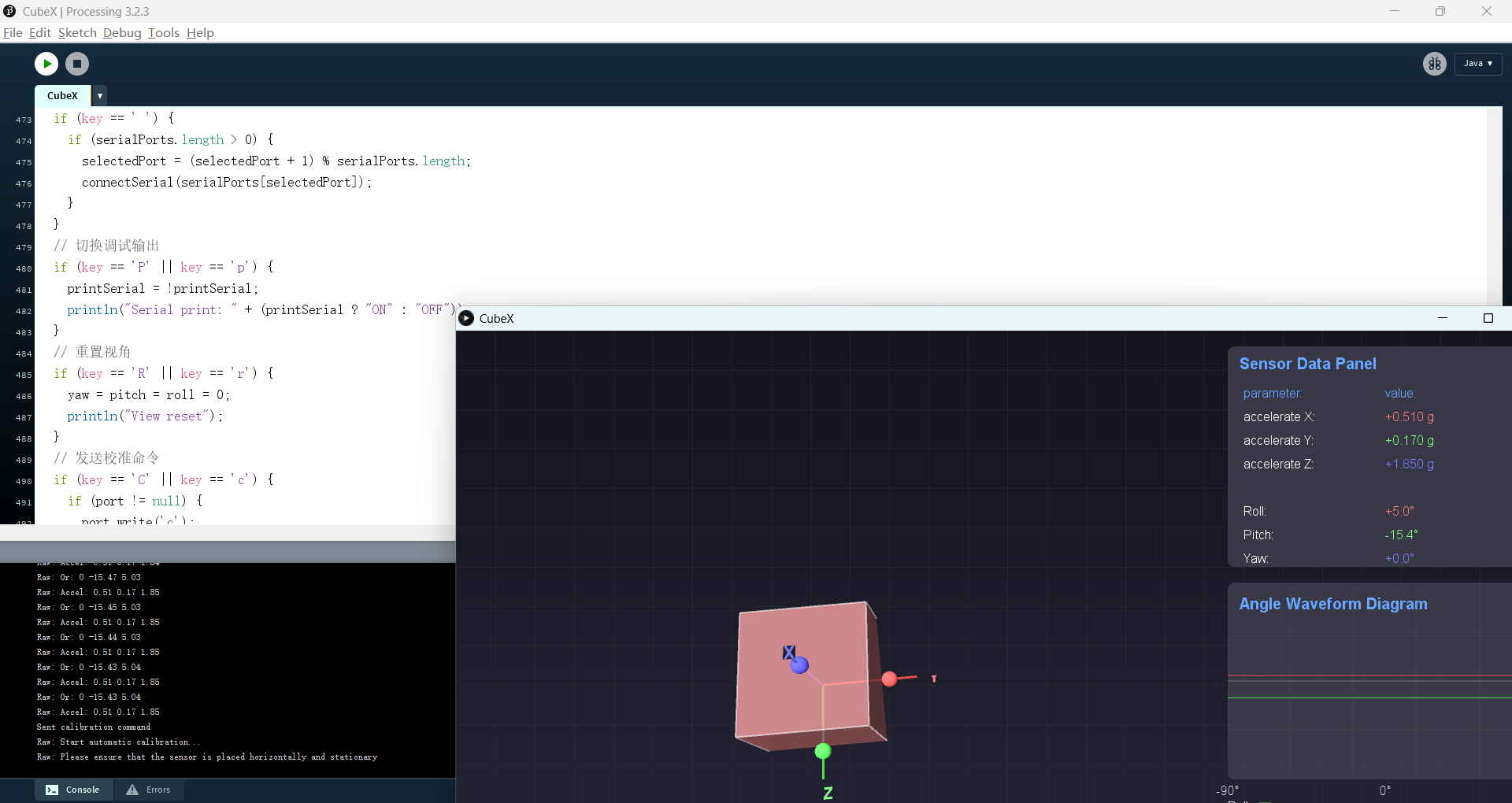
打开操作窗口,按下键盘'C'键发送校准命令
(2)等待校准完成提示和偏移量
Sent calibration command
Raw: Start automatic calibration...
Raw: Please ensure that the sensor is placed horizontally and stationary
Raw: Automatic calibration completed!
Raw: XOffset: 0.438828 g, YOffset: 0.470731 g, ZOffset: 1.747395 g
(3)查看串口输出校准后的加速度计数值
3.2 上位机界面展示
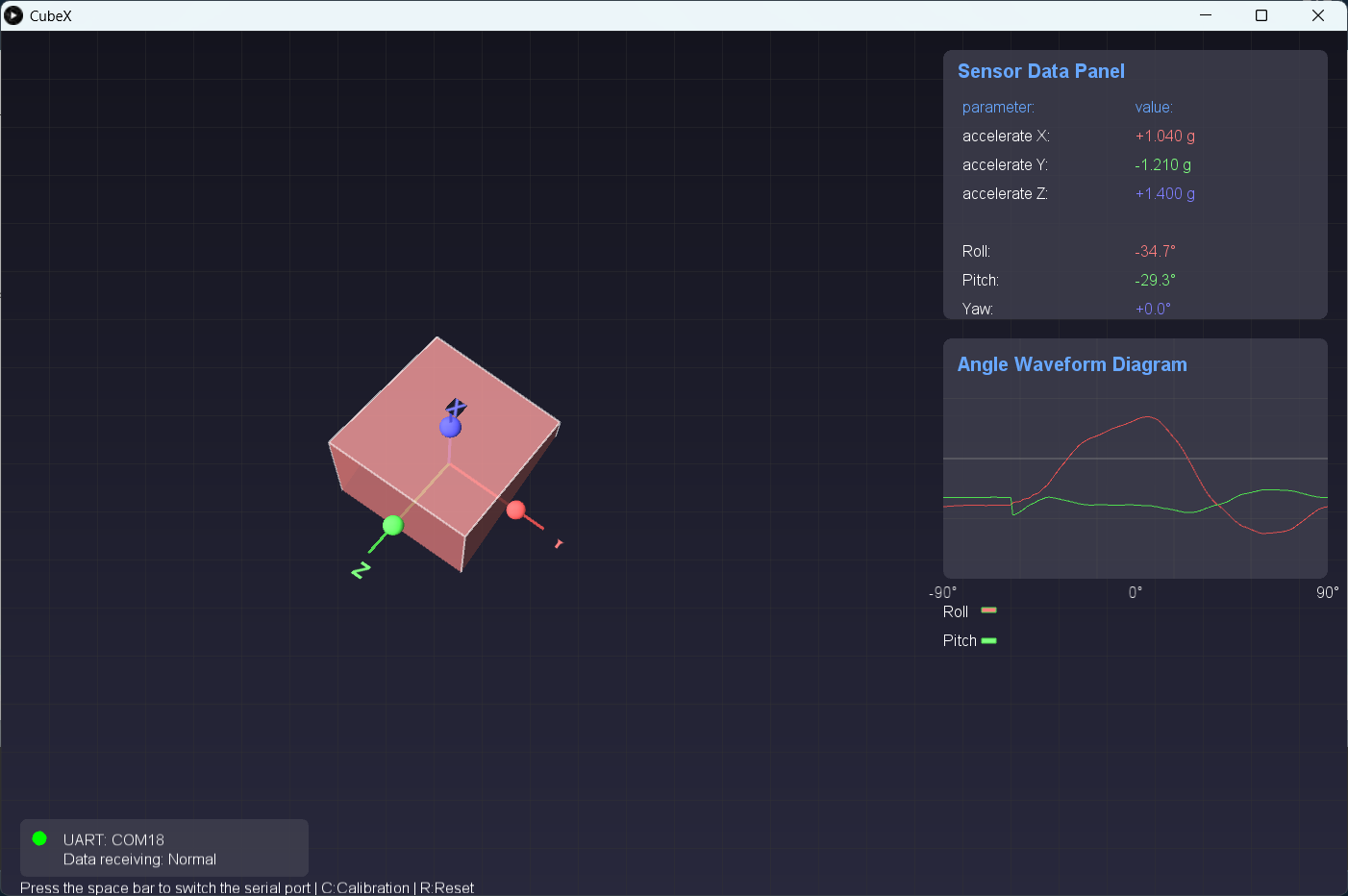
Processing上位机端代码运行后:
左侧显示三维立方体效果、右侧展示数据面板
3.3 视频演示
ADXL345加速度计进行Processing上位机展示
倾斜改变ADXL345传感器的不同方向实时观察上位机3D模型姿态变化
四、ADXL345寄存器工作原理
4.1 DATA_FORMAT寄存器(0x31)
控制数据的表示寄存器0x32到0x37,同时设置分辨率

4.2 BW_RATE寄存器(0x2C)
输出数据速率为200HZ(BW_RATE寄存器中的LOW_POWER位(D4) = 0,速率位(D3:D0) = 0xB)

4.3 POWER_CTL寄存器(0x2D)
设置POWER_CTL寄存器为0x08测量模式

4.4 加速度计I2C通信
若将 CS 引脚接至 V DD I/O,ADXL345 便会进入 I2C 模式,此时仅需简单的 2 线式连接即可。
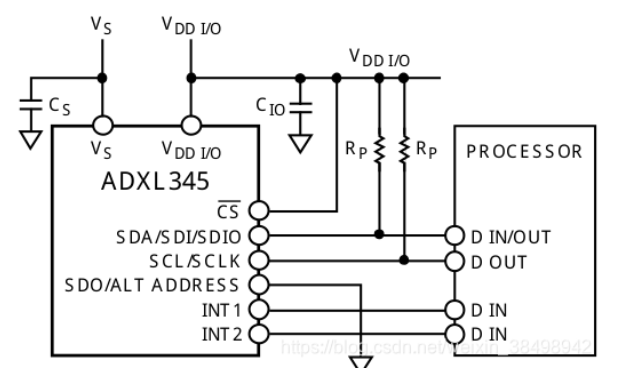
当 ALT ADDRESS 引脚为高电平时,器件的 7 位 I2C 地址为 0x1D,后续紧跟 R/W 位,对应写入地址为 0x3A,读取地址为 0x3B。若把 ALT ADDRESS 引脚(即引脚 12)接地,则可选用备用 I2C 地址 0x53(后续同样紧跟 R/W 位),相应的写入地址为 0xA6,读取地址为 0xA7。
五、常见问题解答
Q1: 传感器数据出现NaN值怎么办?
A: 检查硬件连接是否稳定,确保I2C通信正常。代码中已添加NaN检测和保护机制。
Q2: 如何提高角度计算精度?
A: 可以进行多次校准,确保校准时设备完全水平静止。也可以调整滤波参数优化性能。
Q3: 为什么三维立方体显示不全或位置不正确?
A: 需要调整Processing中的坐标系变换参数,确保模型在视图中心,并正确设置旋转顺序。
项目资源:
上位机平台下载:Processing官网
加速度计技术手册:ADXL345 (Rev. G)
结论: 通过精心设计的滤波算法和自动校准机制,有效解决了MEMS加速度计的噪声和漂移问题。